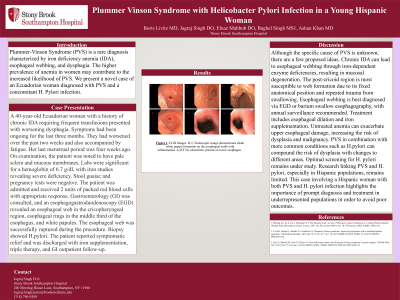Tuesday Poster Session
Category: Esophagus
P3990 - Plummer Vinson Syndrome with Helicobacter pylori Infection in a Young Hispanic Woman
Tuesday, October 29, 2024
10:30 AM - 4:00 PM ET
Location: Exhibit Hall E

Has Audio
- BL
Boris Livitz, MD
Stony Brook Southampton Hospital
Patchogue, NY
Presenting Author(s)
Boris Livitz, MD1, Jagraj Singh, DO1, Elnaz Mahbub, DO2, Baghel Singh, MS3, Ahsan Khan, MD4
1Stony Brook Southampton Hospital, Southampton, NY; 2Stony Brook Southampton Hospital, Jamaica, NY; 3American University of Antigua, Southampton, NY; 4Stony Brook Medicine, Southampton, NY
Introduction: Plummer-Vinson Syndrome (PVS) is a rare diagnosis characterized by iron deficiency anemia (IDA), esophageal webbing, and dysphagia. The higher prevalence of anemia in women may contribute to the increased likelihood of PVS. We present a novel case of an Ecuadorian woman diagnosed with PVS and a concomitant H. Pylori infection.
Case Description/Methods: A 40-year-old Ecuadorian woman with a history of chronic IDA requiring frequent transfusions presented with worsening dysphagia. Symptoms had been ongoing for the last three months. They had worsened over the past two weeks and also accompanied by fatigue. Her last menstrual period was four weeks ago. On examination, the patient was noted to have pale sclera and mucous membranes. Labs were significant for a hemoglobin of 6.7 g/dL with iron studies revealing severe deficiency. Stool guaiac and pregnancy tests were negative. The patient was admitted and received 2 units of packed red blood cells with appropriate response. Gastroenterology (GI) was consulted, and an esophagogastroduodenoscopy (EGD) revealed an esophageal web in the cricopharyngeal region, esophageal rings in the middle third of the esophagus, and white papules. The esophageal web was successfully ruptured during the procedure. Biopsy showed H.pylori. The patient reported symptomatic relief and was discharged with iron supplementation, triple therapy, and GI outpatient follow-up.
Discussion: Although the specific cause of PVS is unknown, there are a few proposed ideas. Chronic IDA can lead to esophageal webbing through iron-dependent enzyme deficiencies, resulting in mucosal degeneration. The post-cricoid region is most susceptible to web formation due to its fixed anatomical position and repeated trauma from swallowing. Esophageal webbing is best diagnosed via EGD or barium swallow esophagography, with annual surveillance recommended. Treatment includes esophageal dilation and iron supplementation. Untreated anemia can exacerbate upper esophageal damage, increasing the risk of dysplasia and malignancy. PVS in combination with more common conditions such as H.pylori can compound the risk of dysplasia with changes to different areas. Optimal screening for H. pylori remains under study. Research linking PVS and H. pylori, especially in Hispanic populations, remains limited. This case involving a Hispanic woman with both PVS and H. pylori infection highlights the importance of prompt diagnosis and treatment in underrepresented populations in order to avoid poor outcomes.
Disclosures:
Boris Livitz, MD1, Jagraj Singh, DO1, Elnaz Mahbub, DO2, Baghel Singh, MS3, Ahsan Khan, MD4. P3990 - Plummer Vinson Syndrome with <i>Helicobacter pylori</i> Infection in a Young Hispanic Woman, ACG 2024 Annual Scientific Meeting Abstracts. Philadelphia, PA: American College of Gastroenterology.
1Stony Brook Southampton Hospital, Southampton, NY; 2Stony Brook Southampton Hospital, Jamaica, NY; 3American University of Antigua, Southampton, NY; 4Stony Brook Medicine, Southampton, NY
Introduction: Plummer-Vinson Syndrome (PVS) is a rare diagnosis characterized by iron deficiency anemia (IDA), esophageal webbing, and dysphagia. The higher prevalence of anemia in women may contribute to the increased likelihood of PVS. We present a novel case of an Ecuadorian woman diagnosed with PVS and a concomitant H. Pylori infection.
Case Description/Methods: A 40-year-old Ecuadorian woman with a history of chronic IDA requiring frequent transfusions presented with worsening dysphagia. Symptoms had been ongoing for the last three months. They had worsened over the past two weeks and also accompanied by fatigue. Her last menstrual period was four weeks ago. On examination, the patient was noted to have pale sclera and mucous membranes. Labs were significant for a hemoglobin of 6.7 g/dL with iron studies revealing severe deficiency. Stool guaiac and pregnancy tests were negative. The patient was admitted and received 2 units of packed red blood cells with appropriate response. Gastroenterology (GI) was consulted, and an esophagogastroduodenoscopy (EGD) revealed an esophageal web in the cricopharyngeal region, esophageal rings in the middle third of the esophagus, and white papules. The esophageal web was successfully ruptured during the procedure. Biopsy showed H.pylori. The patient reported symptomatic relief and was discharged with iron supplementation, triple therapy, and GI outpatient follow-up.
Discussion: Although the specific cause of PVS is unknown, there are a few proposed ideas. Chronic IDA can lead to esophageal webbing through iron-dependent enzyme deficiencies, resulting in mucosal degeneration. The post-cricoid region is most susceptible to web formation due to its fixed anatomical position and repeated trauma from swallowing. Esophageal webbing is best diagnosed via EGD or barium swallow esophagography, with annual surveillance recommended. Treatment includes esophageal dilation and iron supplementation. Untreated anemia can exacerbate upper esophageal damage, increasing the risk of dysplasia and malignancy. PVS in combination with more common conditions such as H.pylori can compound the risk of dysplasia with changes to different areas. Optimal screening for H. pylori remains under study. Research linking PVS and H. pylori, especially in Hispanic populations, remains limited. This case involving a Hispanic woman with both PVS and H. pylori infection highlights the importance of prompt diagnosis and treatment in underrepresented populations in order to avoid poor outcomes.
Disclosures:
Boris Livitz indicated no relevant financial relationships.
Jagraj Singh indicated no relevant financial relationships.
Elnaz Mahbub indicated no relevant financial relationships.
Baghel Singh indicated no relevant financial relationships.
Ahsan Khan indicated no relevant financial relationships.
Boris Livitz, MD1, Jagraj Singh, DO1, Elnaz Mahbub, DO2, Baghel Singh, MS3, Ahsan Khan, MD4. P3990 - Plummer Vinson Syndrome with <i>Helicobacter pylori</i> Infection in a Young Hispanic Woman, ACG 2024 Annual Scientific Meeting Abstracts. Philadelphia, PA: American College of Gastroenterology.
